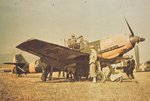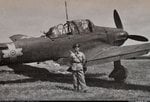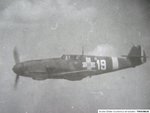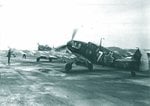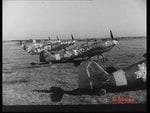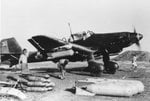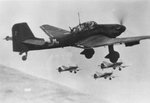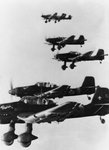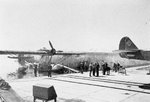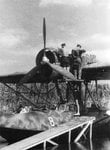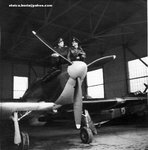Romania has a old and proud aviation history, being one of the few countries in the world to imagine, build and fly various types of aircraft. This history of aviation in Romania began very early in 1529, with the work of Conrad Haas, an artillery engineer and chief of arsenal of the town of Sibiu. Haas, a complex personality of the Renaissance, is nevertheless the father of the multi-stage rocket. He wrote about the construction of multistage rockets and tested many models in flight. Apparently these are the earliest existent writings about the science of rocket engineering in Europe.
After the pioneering work of Conrad Haas in the 16th Century, the next known written document that deals with rocket-building and fireworks has its origin between 1784 and 1801 in Moldavia, another Romanian Principality. The text is part of a larger document of a great Moldavian family, the Conachi. The writing probably belongs to Gavril Conachi (Great Minister of Internal Affairs in 1785), schooled in mathematics and technology, initiated into the knowledge of ballistics. The language used in this text has technical terms coming from different sources, which is common for that time. It has 22 sketches without dimensions and guide marks, and a table with eight variants of rockets, arranged according to the mass of the fuel. The manuscript offers necessary details for the construction and use of a part of the rocket components. The rockets were used for fireworks and for besieging fortified towns.
The tradition in fireworks and rocket-building has a continuation in the modern period of Romanian history by a number of printed books that deal with this specific field of aviation. One of them "Treatise on light pyrotechnics used in field warfare and sieges" was written by lieutenant Stergeanu, active in the Engineer Corps of the 2nd Regiment from Focsani. It was published in Bucharest at Modern printing house in 1892, and has 233 pages divided into 12 chapters, with 182 sketches which permit, in some cases, a better understanding of the text.
One of the first suggestions for equipping a dirigible with a jet engine dates back as far as 1886, when Romanian inventor Alexandru Ciurcu (1884-1922), together with Frenchman Just Buisson, suggested that an aerostat built and exhibited with an electric engine at the Paris Exhibition of Electricity in 1881 be provided instead with their jet cylinder. Ciurcu built and tested their original first jet engine on a small ship running on the Seine River in Paris in 1886 and on a rail car in 1888. In 1910 a small Flying Corps (Corpul Aerian Romana) was established by the Romanian Army. During the First World War the Flying Corps disintegrated as the country was overrun by Austro-German forces.
On April 1st 1913, the Romanian Parliament voted the law of the military aviation, Romania being the fifth nation in the world to have an Air Force. The law on the organization of Military Aeronautics stipulated the independent existence of the aeronautics within the Engineers Command. Also Romania was one of the first nations in the world to use aircraft in the war, during the Balkans War in 1913. After Balkans war, on 10 August 1915 by the Higher Royal Decree No. 305, Corpul Aerian Roman - Romanian Flying Corps - was established, having 80 pilots and 25 air observers. It was directly subordinated to the Ministry of War and included all the operational aviation and aerostation structures.
During the First World War the Flying Corps pilots and aircraft of the Romanian Air Corps fought with German Air Force winning many victories and performing air reconnaissance missions, but finally disintegrated as the country was overrun by Austro-German forces. After the Romanian government was re-established in 1918, it set about forming a new air arm, called the Divizia 1 Aeriana (1st Air Division), under a Directorate of Army Aviation. The new air arm expanded rapidly, and was able to rely increasingly on the domestic aircraft industry. Unfortunately, when World War Two arrived, most of this equipment was obsolete and, with Romania staying neutral, it became difficult to obtain new aircraft from abroad. In September 1940, a Luftwaffe advisory mission arrived to reorganize the air force, (by now called the Fortele Aeriene Regale Romane - Royal Romanian Air Force), and on 23 November 1940 Romania signed the Axis Tripartite Pact.
The number of German 'instructors' was progressively increased, as was the quantity of German aircraft supplied. When Germany attacked Russia on 22 June 1941, Romanian air elements supported the German attack on the Bessarabian front to liberate Eastern part of Romania, occupied in 1940 by Soviet troops. By the beginning of 1944, the Romanian squadrons operating in Russia had suffered huge losses, equivalent to almost half of the total front-line strength of the Romanian air force. The severely weakened force was withdrawn to help with countering growing Allied air attacks on the Ploiesti oil fields. The antifascist coup of 23 August 1944 took the Germans completely by surprise. Attempts were made to move German troops into Bucharest by air, but as the Romanians held all the serviceable airfields, the operation was cancelled. Romanian Air Force fought the rest of the war against Germany, being active in combats to liberate Romanian territory, Hungary, Czechoslovakia and Austria, until the final victory on 8 May 1945. During WW II, Romanian pilots proved their abilities as fighter pilots, the most known aces being Constantin "Bâzu" Cantacuzino, Alexandru Serbanescu, Ion Dobran, Vasile "Chitu" Gavriliu, Ion Milu, among many others.
After the pioneering work of Conrad Haas in the 16th Century, the next known written document that deals with rocket-building and fireworks has its origin between 1784 and 1801 in Moldavia, another Romanian Principality. The text is part of a larger document of a great Moldavian family, the Conachi. The writing probably belongs to Gavril Conachi (Great Minister of Internal Affairs in 1785), schooled in mathematics and technology, initiated into the knowledge of ballistics. The language used in this text has technical terms coming from different sources, which is common for that time. It has 22 sketches without dimensions and guide marks, and a table with eight variants of rockets, arranged according to the mass of the fuel. The manuscript offers necessary details for the construction and use of a part of the rocket components. The rockets were used for fireworks and for besieging fortified towns.
The tradition in fireworks and rocket-building has a continuation in the modern period of Romanian history by a number of printed books that deal with this specific field of aviation. One of them "Treatise on light pyrotechnics used in field warfare and sieges" was written by lieutenant Stergeanu, active in the Engineer Corps of the 2nd Regiment from Focsani. It was published in Bucharest at Modern printing house in 1892, and has 233 pages divided into 12 chapters, with 182 sketches which permit, in some cases, a better understanding of the text.
One of the first suggestions for equipping a dirigible with a jet engine dates back as far as 1886, when Romanian inventor Alexandru Ciurcu (1884-1922), together with Frenchman Just Buisson, suggested that an aerostat built and exhibited with an electric engine at the Paris Exhibition of Electricity in 1881 be provided instead with their jet cylinder. Ciurcu built and tested their original first jet engine on a small ship running on the Seine River in Paris in 1886 and on a rail car in 1888. In 1910 a small Flying Corps (Corpul Aerian Romana) was established by the Romanian Army. During the First World War the Flying Corps disintegrated as the country was overrun by Austro-German forces.
On April 1st 1913, the Romanian Parliament voted the law of the military aviation, Romania being the fifth nation in the world to have an Air Force. The law on the organization of Military Aeronautics stipulated the independent existence of the aeronautics within the Engineers Command. Also Romania was one of the first nations in the world to use aircraft in the war, during the Balkans War in 1913. After Balkans war, on 10 August 1915 by the Higher Royal Decree No. 305, Corpul Aerian Roman - Romanian Flying Corps - was established, having 80 pilots and 25 air observers. It was directly subordinated to the Ministry of War and included all the operational aviation and aerostation structures.
During the First World War the Flying Corps pilots and aircraft of the Romanian Air Corps fought with German Air Force winning many victories and performing air reconnaissance missions, but finally disintegrated as the country was overrun by Austro-German forces. After the Romanian government was re-established in 1918, it set about forming a new air arm, called the Divizia 1 Aeriana (1st Air Division), under a Directorate of Army Aviation. The new air arm expanded rapidly, and was able to rely increasingly on the domestic aircraft industry. Unfortunately, when World War Two arrived, most of this equipment was obsolete and, with Romania staying neutral, it became difficult to obtain new aircraft from abroad. In September 1940, a Luftwaffe advisory mission arrived to reorganize the air force, (by now called the Fortele Aeriene Regale Romane - Royal Romanian Air Force), and on 23 November 1940 Romania signed the Axis Tripartite Pact.
The number of German 'instructors' was progressively increased, as was the quantity of German aircraft supplied. When Germany attacked Russia on 22 June 1941, Romanian air elements supported the German attack on the Bessarabian front to liberate Eastern part of Romania, occupied in 1940 by Soviet troops. By the beginning of 1944, the Romanian squadrons operating in Russia had suffered huge losses, equivalent to almost half of the total front-line strength of the Romanian air force. The severely weakened force was withdrawn to help with countering growing Allied air attacks on the Ploiesti oil fields. The antifascist coup of 23 August 1944 took the Germans completely by surprise. Attempts were made to move German troops into Bucharest by air, but as the Romanians held all the serviceable airfields, the operation was cancelled. Romanian Air Force fought the rest of the war against Germany, being active in combats to liberate Romanian territory, Hungary, Czechoslovakia and Austria, until the final victory on 8 May 1945. During WW II, Romanian pilots proved their abilities as fighter pilots, the most known aces being Constantin "Bâzu" Cantacuzino, Alexandru Serbanescu, Ion Dobran, Vasile "Chitu" Gavriliu, Ion Milu, among many others.
Last edited:





